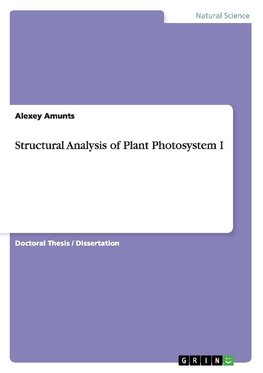
-
 Anglický jazyk
Anglický jazyk
Structural Analysis of Plant Photosystem I
Autor: Alexey Amunts
Doctoral Thesis / Dissertation from the year 2010 in the subject Biology - Ecology, Tel Aviv University, language: English, abstract: Photosystem I (PSI) is a multi-subunit and intricate membrane super-complex of protein and non-protein components that catalyzes... Viac o knihe
Na objednávku
49.05 €
bežná cena: 54.50 €
O knihe
Doctoral Thesis / Dissertation from the year 2010 in the subject Biology - Ecology, Tel Aviv University, language: English, abstract: Photosystem I (PSI) is a multi-subunit and intricate membrane super-complex of protein and non-protein components that catalyzes one of the first steps of oxygenic photosynthesis. PSI captures sunlight through a highly sophisticated pigment network and consequently converts the solar energy into its chemical form providing essential food and fuel to power life on the Earth. PSI operates with the unprecedented quantum efficiency of close to 100%. For this reason, it is regarded as the most efficient light capturing and energy conversion device in Nature.
The ability of PSI to convert sunlight energy is highly dependent on the precise spatial arrangement of protein subunits and the relative positions of numerous cofactors. For this reason, we took the challenge of the crystallographic determination of plant PSI structure at a resolution that would allow estimation of single atoms and therefore enable positive identification of most of the amino acid and chlorophyll conformations.
We solved the structure of the intact PSI at 3.3 Å resolution that revealed exquisitely organized ~600 kDa complex of 18 protein subunits, with 46 transmembrane helices and total of 195 cofactors, comprising one of the most complicated membrane protein structures unraveled by the X-ray crystallography. The structure clarifies at almost atomic level how plant PSI links absorption of photons to production of chemical energy, according to the blueprints of protein-pigment network, and reveals working principles of photosynthetic antenna system.
The three-dimensional description laid the foundation for further structural analysis that discusses how the biological significance of plant PSI is matched by its structural elements. For example, we analyzed the interactions of plant PSI with its electron donors and acceptors, highlighting the differences from its cyanobacterial counterpart. We also examined the complete interaction network among the protein subunits that collectively constitute plant PSI. This information may be useful for understanding how this intricate complex is assembled and turned over after photo-damage.
In addition, the structure allowed to propose a logic basis for the unique 'state transitions' phenomenon in photosynthesis, and thus explained how crucial changes in PSI modality during the evolution contributed to the development of the terrestrial life on Earth about 1.5 billion years ago.
- Vydavateľstvo: GRIN Verlag
- Rok vydania: 2011
- Formát: Paperback
- Rozmer: 210 x 148 mm
- Jazyk: Anglický jazyk
- ISBN: 9783656019374












